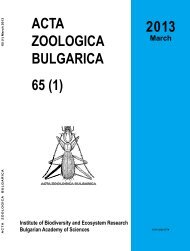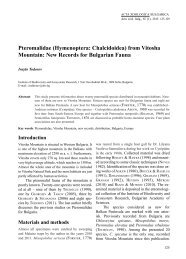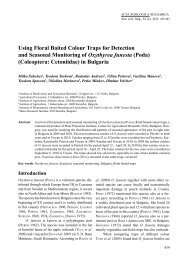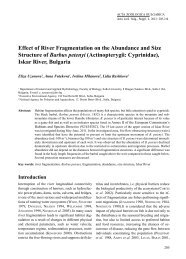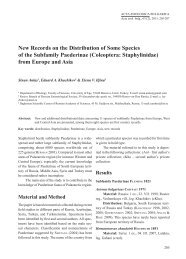(Epicometis) hirta (PODA) - Acta zoologica bulgarica
(Epicometis) hirta (PODA) - Acta zoologica bulgarica
(Epicometis) hirta (PODA) - Acta zoologica bulgarica
Create successful ePaper yourself
Turn your PDF publications into a flip-book with our unique Google optimized e-Paper software.
Employing Floral Baited Traps for Detection<br />
and Seasonal Monitoring of Tropinota (<strong>Epicometis</strong>)<br />
<strong>hirta</strong> (Po d a) (Coleoptera: Cetoniidae) in Bulgaria<br />
Introduction<br />
Scarabaeids are important group of beetles in regard<br />
to both systematics and economics. Adults of<br />
many species are phytophagous and feed on leaves<br />
and flours of cultural plants (Hu r p i n 1962). Family<br />
Cetoniidae (Coleoptera: Scarabaeoidea) includes<br />
several important pests like Tropinota <strong>hirta</strong> po d a,<br />
Cetonia aurata L., Oxythyrea funesta po d a, etc.<br />
This was the reason for organizing a survey on the<br />
distribution and seasonal appearance of some of the<br />
main beetle pests belonging to this family using floral<br />
baited colour traps.<br />
The first object of our investigation was T. <strong>hirta</strong>.<br />
It is known as an important pest attacking many cul-<br />
ACTA ZOOLOGICA BULGARICA<br />
<strong>Acta</strong> zool. bulg., 63 (3), 2011: 269-276<br />
Mitko A. Subchev 1 , Teodora B. Toshova 1 , Radoslav A. Andreev 2 , Vilina D. Petrova 3 , Vasilina D.<br />
Maneva 4 , Teodora S. Spasova 5 , Nikolina T. Marinova 5 , Petko M. Minkov, Dimitar I. Velchev 6<br />
1 Institute of Biodiversity and Ecosystem Research, 2 Gagarin str., 1113 Sofia, Bulgaria<br />
2 Agricultural University, 12Mendeleev str., 4000 Plovdiv, Bulgaria<br />
3 Institute of Agriculture, Sofijsko shoes, 2500 Kyustendil, Bulgaria<br />
4 Institute of Agriculture, 1 Industrialna str., 8400 Karnobat, Bulgaria<br />
5 Institute of Mountainous Animal Breeding and Agriculture, 281 Vasil Levski str, 5600 Troyan, Bulgaria<br />
6 Maize Research Institute, 5835 Knezha, Bulgaria<br />
Abstract: The potential of commercially available light blue VARb3k traps and baits for T. <strong>hirta</strong> (Csalomon ® , Plant<br />
Protection Institute, Budapest, Hungary) as a new tool for detection and describing the seasonal flight patterns<br />
of Tropinota (<strong>Epicometis</strong>) <strong>hirta</strong> (po d a) was proved in eight sites in Bulgaria in 2009 and 2010. The<br />
traps showed very high efficiency in both cases of high and low population level of the pest. Significant<br />
catches of T. <strong>hirta</strong> were recorded in Dryanovo, Karnobat, Knezha, Kyustendil, Petrich and Plovdiv. As a<br />
whole the beetles appeared in the very end of March – beginning of April and reached their peak flight in<br />
the second half of April – beginning of May; catches were recorded up to the middle of July. The bait/traps<br />
system used in our field work showed very high species selectivity. In nine out of ten cases the catches<br />
of T. <strong>hirta</strong> exceeded 90% and in six of these this percent was equal or more than 99%, including Petrich<br />
where only T. <strong>hirta</strong> were caught in 2009.<br />
Key words: Tropinota (<strong>Epicometis</strong>) <strong>hirta</strong>, detection, seasonal monitoring, Bulgaria, floral baited traps<br />
tural plants by feeding on stamens, pistils and other<br />
parts of their flowers in different countries in Europe,<br />
e.g. Austria (Bö H m 1950), Bulgaria (CH o r B a d j i e v<br />
1932; Bu r e s H, La z a r o v 1956, po p o va 1962, 1968),<br />
Croatia (Ra ž o v et al. 2009), Hungary (Ho m o n n ay n é,<br />
Ho m o n n ay n é-Cs e H i 1990), Serbia (Sta m e n k o v i ć,<br />
mi l e n k o v i ć 1996). po p o va (1962) listed 37 food<br />
plants for T. <strong>hirta</strong> in Bulgaria belonging to seven<br />
families. To this list 11 more species should be added<br />
(CH o r B a d z H i e v 1932, Bu r e s H, La z a r o v 1956).<br />
According to za s H e v, Ke r e m e d C H i e v (1968) T. <strong>hirta</strong><br />
attacks also different forest trees, including Salix sp.<br />
and Populus sp.<br />
269
Subchev M., T. Toshova, R. Andreev, V. Petrova, V. Maneva, T. Spasova, N. Marinova, P. Minkov, D. Velchev<br />
Tó T H et al. (2003) found three compounds attracting<br />
T. <strong>hirta</strong> in field: cinnamyl alcohol, transanethol<br />
and cinnamyl acetate. Further tests showed<br />
that the combination of light blue colour and a bait<br />
of 1:1 mixture of cinnamyl alcohol and trans-anethol<br />
used in dry funnel traps are very effective tool for<br />
catching both males and females of the pest (sC H m e r a<br />
et al. 2004). Later, as a result of ellectrantenographic<br />
screening of 27 synthetic compounds (most of them<br />
floral) and further testing of the most active ones<br />
among them, a new coattractant increasing the attractiveness<br />
of cinnamyl alcohol/trans-anethol mixture<br />
was found: 4-methoxyphenethyl alcohol significantly<br />
increases catches of T. <strong>hirta</strong> when added to the<br />
known binary attractant mixture (vu T s et al. 2010b).<br />
Floral baited blue dry traps have already been successfully<br />
used for detection and/or seasonal monitoring<br />
of T. <strong>hirta</strong> in Bulgaria (mi r C H e va et al. 2004),<br />
Hungary, Croatia and Italy (Tó T H et al. 2009).<br />
The objective of the present research was to<br />
prove the potential and species-specificity of floral<br />
baited traps as a new tool for establishing the possible<br />
presence of T. <strong>hirta</strong> in several regions in Bulgaria and<br />
describing the seasonal flight patterns of the pest in<br />
the sites where its population level allows this to be<br />
done. Information about other species of superfamily<br />
Scarabaeoidea captured in the traps is also given.<br />
Materials and Methods<br />
Commercially available VARb3k traps with a light<br />
blue upper funnel and baits for T. <strong>hirta</strong> were purchased<br />
from Csalomon ® (Plant Protection Institute,<br />
Budapest, Hungary) and used in our field work. Two<br />
traps (together with two traps for each C. aurata<br />
270<br />
and O. funesta) were set in eight sites in Bulgaria<br />
in 2009-2010 in: Dryanovo, Gabrovo, Karnobat,<br />
Knezha, Kyustendil, Petrich, Plovdiv and Troyan.<br />
Details of the experimental work are shown in Table<br />
1. The traps, installed on the ground or at a height<br />
of 50-100 cm above, were visited weekly and the<br />
beetles caught were collected and identified in laboratory<br />
using Ba r a u d (1992) and me d v e d e v (1965).<br />
Only in Gabrovo the traps were visited irregularly at<br />
10-15 day intervals.<br />
Results<br />
Significant catches of T. <strong>hirta</strong> were recorded in six of<br />
the experimental sites during 2009. No beetles of this<br />
species were caught in Troyan and only three beetles<br />
were caught in Gabrovo in 2009 which was the reason<br />
not to go on with the observations at these sites<br />
in 2010. We failed to organize further observation in<br />
Petrich and this site was also excluded in 2010 but<br />
another site, Knezha, was added. Significant catches<br />
were recorded in all five sites investigated during<br />
2010. The most numerous catches were recorded in<br />
Kyustendil and Petrich in 2009 and in Knezha and<br />
Kyustendil in 2010 (Table 2).<br />
The trend of the seasonal flight of T. <strong>hirta</strong> in all<br />
the sites of investigations was similar in both 2009<br />
and 2010. As a whole the beetles appeared in the<br />
very end of March – beginning of April and reached<br />
their peak flight in the second half of April – beginning<br />
of May. The latest catches were recorded<br />
in Karnobat (July 2, 2010) and Kyustendil (July 14<br />
2010), (Fig. 1-5).<br />
The bait/traps system used in our field work<br />
showed very high species selectivity. In nine out of<br />
Table 1. Details of the field tests. The altitude of towns is taken from: http://bg.guide-bulgaria.com/<br />
Region Altitude Vegetation<br />
Date of setting<br />
the traps<br />
Date of collecting<br />
the traps<br />
2009 2010 2009 2010<br />
Dryanovo 200-299 m Mixed orchard 25.03 27.03 31.08 26.07<br />
Gabrovo 300-499 m Mixed orchard 02.04 - 15.08 -<br />
Karnobat 200-299 m Mixed park (tress and bushes) vegetation 25.03 12.03 31.08 30.07<br />
Knezha 100-199 m<br />
Various cereals (maize, sunflower,<br />
wheat, oats)<br />
- 12.03 - 27.08<br />
Kyustendil 500-699 m Mixed orchard 30.03 17.03 25.08 28.07<br />
Petrich 100-199 m Peach orchard 17.03 - 31.08 -<br />
Plovdiv 100-199 m Mixed orchard 27.03 19.03 28.08 27.07<br />
Troyan 300-499 m Mixed orchard 25.03 - 31.08 -
Employing of Floral Baited Traps for Detection and Seasonal Monitoring of Tropinota...<br />
Table 2. Catches of T. <strong>hirta</strong> in two target traps in each of<br />
eight sites in Bulgaria during 2009 and 2010.<br />
Site<br />
Total number of beetles<br />
caught<br />
2009 2010<br />
Dryanovo 90 34<br />
Gabrovo 3 -<br />
Karnobat 165 15<br />
Knezha - 1408<br />
Kyustendil 1700 660<br />
Petrich 701 -<br />
Plovdiv 157 274<br />
Troyan 0 -<br />
ten cases the catches of T. <strong>hirta</strong> exceeded 90% and in<br />
six of these this percent was equal or more than 99%,<br />
including Petrich where only T. <strong>hirta</strong> were caught in<br />
2009. The other scarabaeid beetles, besides the target<br />
one, caught in the traps were O. funesta, C. aurata,<br />
Protaetia (Netocia) cuprea (Fa B r i C i u s), Valgus<br />
hemipterus (L.), Blitopertha lineolata (Fi s C H e r v o n<br />
Wa L d H e i n), Anisoplia (Autanisoplia) austriaca<br />
(He r B s T) and Trichius fasciatus (L.); all of them with<br />
the exception of the last one are pest species (Fig. 6).<br />
Discussion<br />
Our results have shown that the commercially light<br />
blue VARb3k traps and baits for T. <strong>hirta</strong> (Csalomon ® ,<br />
Plant Protection Institute, Budapest, Hungary) are<br />
very potent tool for attracting and capturing the beetles<br />
of this species in both cases of a high population<br />
level and low population level of the pest.<br />
T. <strong>hirta</strong> is known as widely distributed pest in<br />
Bulgaria. One of the first reviews on the distribution<br />
and host plants of T. <strong>hirta</strong> in Bulgaria is that<br />
of CH o r B a d j i e v (1932). More recent publications<br />
also showed that the pest is polyphagous and widely<br />
distributed in this country (Bu r e s H, La z a r o v 1956;<br />
po p o va 1962; 1968). The results of our recent investigations<br />
confirmed to a great extent this. It worth<br />
mentioning the absence of the pest in Troyan in 2009<br />
which is in accordance with the results obtained earlier<br />
at the same spot – only few beetles of this species<br />
were caught in 25 traps operating whole season in<br />
Fig. 1. Seasonal flight of T. <strong>hirta</strong> in Dryanovo, 2009 and 2010. Arrows (↓) show the dates of installing and reinstalling<br />
the traps in the field. Asterisks (*) mark the date when the baits were renewed.<br />
271
Subchev M., T. Toshova, R. Andreev, V. Petrova, V. Maneva, T. Spasova, N. Marinova, P. Minkov, D. Velchev<br />
Fig. 2. Seasonal flight of E. <strong>hirta</strong> in Karnobat, 2009 and 2010. For symbols see the legend for Fig. 1.<br />
Fig. 3. Seasonal flight of T. <strong>hirta</strong> in Kyustendil, 2009 and 2010. For symbols see the legend for Fig. 1.<br />
272
Employing of Floral Baited Traps for Detection and Seasonal Monitoring of Tropinota...<br />
Fig. 4. Seasonal flight of T. <strong>hirta</strong> in Plovdiv, 2009 and 2010. For symbols see the legend for Fig. 1.<br />
Fig. 5. Seasonal flight of T. <strong>hirta</strong> in Petrich, 2009 and Knezha, 2010. For symbols see the legend for Fig. 1.<br />
273
Subchev M., T. Toshova, R. Andreev, V. Petrova, V. Maneva, T. Spasova, N. Marinova, P. Minkov, D. Velchev<br />
Fig. 6. Percentage distribution of scarabaeid beetles caught in traps with baits for T. <strong>hirta</strong> at six sites in Bulgaria<br />
in 2009-2010.<br />
274
Employing of Floral Baited Traps for Detection and Seasonal Monitoring of Tropinota...<br />
2006 (su B C H e v, spa s o va unpublished data). On the<br />
other hand a total of 25 T. <strong>hirta</strong> beetles were caught<br />
in traps for C. aurata and O. funesta at the same site<br />
in 2010 (su B C H e v et al. unpublished data). This low<br />
population level of the pest in Troyan is difficult for<br />
explanation. One possible reason could be the relatively<br />
high altitude but we recorded very high population<br />
level of the pest at another site, Kyustendil,<br />
located at almost the same altitude.<br />
According to CH o r B a d j i e v (1932), T. <strong>hirta</strong> beetles<br />
appeared in April, reached their peak in the beginning<br />
and the first half of May and then disappeared in<br />
the middle of June after which only single exemplars<br />
were observed. The more accurate study of po p o va<br />
(1962) carried out in 1957-1959 showed that T. <strong>hirta</strong><br />
appeared in the field from March 5 to April 4 and<br />
the flight lasted until July 8 – July 24. The results of<br />
our earlier field investigations with same VARb3k<br />
traps and carried out in 2000 in Kyustendil showed<br />
an earlier flight of the pest as compared to the results<br />
at the same site reported in the present paper<br />
for 2009 and 2010. Summarizing the data available<br />
we could conclude that in Bulgaria T. <strong>hirta</strong> appeared<br />
in March – beginning of April and could be observed<br />
in the field up to the end of July depending on the<br />
climatic conditions of the year. Similarly the term<br />
of the peak flight vary in the period of the second<br />
half of April – first half of May. Tó T H et al. (2009)<br />
reported similar results obtained by the same traps:<br />
in Hungary, Croatia and Italy the pest appeared at the<br />
end of March or early April and the peak flight was<br />
References<br />
Bar a u d J. 1992. Coléoptères Scarabaeoidea d´Europe. Faune<br />
de France, vol. 78. Féderation Française des Societés de<br />
Sciences Naturelles. Lyon, 856 p.<br />
BöH m H. 1950. Beobachtungen iiber das Auftreten des rauhhaariges<br />
Roseokäfers als Schädling von Obstbaumblüten in<br />
Österreich (Tropinota (<strong>Epicometis</strong>) <strong>hirta</strong> Poda). – Pflanzenschutzberichte,<br />
5 (3-4): 241-257.<br />
Bu r e s H i., a. La z a r o v 1956. Vrednite nasekomi za selskoto i<br />
gorskoto stopanstvo v Balgariya. Balgarska Akademiya<br />
na naukite, Sofia. 289 p. (In Bulgarian).<br />
CH o r B a d z H i e v p. 1932. Die Feinde der Kulturpflanzen während<br />
der Jahre 1928 u. 1929. – Svedeniya po zemedelie. 13 (3-4):<br />
4-48 (In Bulgarian, German abstract).<br />
Hom o n n ay F., é. Ho m o n n ay n é -Cs e H i 1990. Cserebogarak<br />
e Melolonthidae. – In: T. Jermy, K. Balázs (Eds.): A<br />
növényvédelmi állattan kézikönyve (Handbook of Plant<br />
Protection Zoology), vol. 3/A. Akadémiai Kiadó, Budapest,<br />
156-215 (In Hungarian).<br />
recorded in April. According to ne g r o B o v (2009) in<br />
Voronezh province, Russia, T. <strong>hirta</strong> belongs to the<br />
‘late spring – early summer’ phenological group<br />
with an abundance peak in May.<br />
Our results showed also a very high speciesspecificity<br />
of the VARb3k traps which exceeded 90%<br />
in nine of the all ten cases and well correlates with the<br />
literature data. Field experiments organised earlier<br />
in Hungary, Croatia, Bulgaria and Italy have shown<br />
more than 50% T. <strong>hirta</strong> caught in the traps for this<br />
species in whole season observation but at the time<br />
of T. <strong>hirta</strong> flight this percent rise up to 75% (vu T s et<br />
al. 2010a). Of course this ratio between catches of the<br />
target and non-target species such as O. funesta, C.<br />
aurata, V. hemipterus, etc. depends on the occurrence<br />
or absence of some of these species at a certain site<br />
and their population level when present – in the case<br />
of a very low population level of the target species<br />
and high population level of the not-target species<br />
the ratio of the beetles caught could be changed in<br />
the favour of the non-target species. In Italy, another<br />
Tropinota species, Tropinota (Tropinota) squalida<br />
(sC o p o L i) was also attracted into the traps for T. <strong>hirta</strong><br />
(Tó T H et al. 2009). T. squlaida occurs also in Bulgaria<br />
in orchards, vine yards and also on colza and rye<br />
(Bu r e s H, La z a r o v 1956) but never found in our traps<br />
during the recent investigations.<br />
Acknowledgments: Thanks are due to Petya Trayanova, Kircho<br />
Trayanov, Vasilii Abaev and Silvia Terziiska for technical assistance<br />
in the field work. This project was supported by Grant<br />
DO02-244/2008 of the Bulgarian National Scientific Fund.<br />
Hur p i n B. 1962. Super-famille des Scarabaeoidea. – In A. S.<br />
Balachowsky (Ed.): Entomologie appliquée á l’agriculture.<br />
Masson et Cie Éditeurs, Paris, 24-204.<br />
me d v e d e v S. I. 1965. The Family Scarabaeidae. – In G. Y. Bey-<br />
Bienko (Ed.): Determination Keys of Insects of the European<br />
Part of the USSR. Vol. 2. Coleoptera and Strepsiptera.<br />
Moscow-Leningrad, Nauka, 166-208. (In Russian).<br />
mi r C H e va a., m. su B C H e v, i. sr e d K o v, m. Tó T H. 2004. Seasonal<br />
flight of <strong>Epicometis</strong> <strong>hirta</strong> Poda (Coleoptera, Scarabaeidae)<br />
established by attractant traps. – Annuaire de l’Université<br />
de Sofia ‘St. Kliment Ohridski’, 96: 201-204.<br />
neg r o B o v, s. a. 2009. Seasonal dynamics of scarab beetles<br />
(Coleoptera: Lamellicornia) in Voronezh province. – Entomological<br />
Review, 89: 1, 113-115.<br />
niK o L o va v. 1968. Entomotsenologichni i biologichni<br />
prouchvaniya v nasazhdeniya s maslodajna roza. II.<br />
Coleoptera. – Izv. Zool. Inst. Muzei, 26: 119-155. (In<br />
Bulgarian, with Russian abstract).<br />
275
Subchev M., T. Toshova, R. Andreev, V. Petrova, V. Maneva, T. Spasova, N. Marinova, P. Minkov, D. Velchev<br />
pop o va v. 1962. Der zottige Blütenkäfer (<strong>Epicometis</strong> <strong>hirta</strong><br />
Poda – Tropinota <strong>hirta</strong> Poda) und dessen Bekampfung. –<br />
Izvestiya na Tsentralniya nauchmoizsledovatelski institut<br />
po zashtita na rasteniyata, 11: 89-113 (In Bulgarian,<br />
German abstract)<br />
po p o va v. 1968. Mahnatoyat brambar i borbata s nego. – Rastitelna<br />
zashtita, 16 (2): 18-20.<br />
Ra ž o v J., B. Ba R i ć, m. Du t t o 2009. Fauna of the Cetoniid beetles<br />
(Coleoptera: Cetoniidae) and their damages on peach fruits<br />
in orchards of Northern Dalmatia, Croatia. – Entomol.<br />
Croat., 13 (2): 7-20.<br />
sC H m e r a d., m. Tó T H, m. su B C H e v, i. sr e d K o v, i. sz a r u K á n, T.<br />
je r m y , á. szenTesi 2004. Importance of visual and chemical<br />
cues in the development of an attractant trap for <strong>Epicometis</strong><br />
(Tropinota) <strong>hirta</strong> po d a (Coleoptera: Scarabaeidae). – Crop<br />
Prot., 23: 939-944.<br />
si v C e v i., m. Tó T H, i. To m a s e v 2006. Application of attractants<br />
in control of the sugar-beet weevil and the blossom feeder<br />
scarab (Bothynoderes punctiventris, <strong>Epicometis</strong> <strong>hirta</strong>). –<br />
Poljoprivedni Kalendar 2006, 138-140. (In Serbian).<br />
Sta m e n k o v i ć S., S. mi l e m k o v i ć 1996. Rutava buba (Tropinota<br />
<strong>hirta</strong>), značajna štetočina gajenog voća u Moravičkom<br />
okrugu. – Biljni lekar, 14 (6): 537-539. (In Serbian).<br />
Tó T H m., m. g. KLein, z. im r e i 2003. Field screening for attractants<br />
of scarab pests in Hungary (Coleoptera: Scarabaeidae). –<br />
<strong>Acta</strong> Phytopath. Entomol. Hung., 38: 323-331.<br />
Tó T H m., d. sC H m e r a, z. im r e i 2004. Optimization of a chemical<br />
attractant for <strong>Epicometis</strong> (Tropinota) <strong>hirta</strong> Poda. – Z.<br />
Naturforsch. C, 59: 288-292.<br />
Tó T H m., z. im r e i, i. sz a r u K á n, e. vo i g T, d. sC H m e r a, j. vu T s, K.<br />
Ha r m i n C z, m. su B C H e v 2005. Gyümölcs- ill. virágkárokat<br />
276<br />
okozó cserebogárfélék kémiai kommunikációja: egy<br />
évtized kutatási eredményei. – Növényvédelem, 41: 581-<br />
588. (In Hungarian, English abstract).<br />
Tó T H, m., e. vo i g T, z. im r e i, i. sz a r u K á n, d. sC H m e r a, j. vu T s,<br />
K. Ha r m i n C z, m. su B C H e v, i. si v C e v 2006. Semiochemicalbaited<br />
traps for scarab pests damaging fruits and blossoms.<br />
In: 58th International Symposium on Crop Protection, Gent,<br />
Belgium, 23 May, 2006.<br />
Tó T H, m., j. vu T s, F. di F r a n C o, r. TaBiLio, B. Ba r i C, j. ra z o v,<br />
T. To s H o va, m. su B C H e v 2009. Detection and monitoring<br />
of <strong>Epicometis</strong> <strong>hirta</strong> po d a and Tropinota squalida sCo p.<br />
with the same trap. – <strong>Acta</strong> Phytopath. Entomol. Hung.,<br />
44 (2): 337-344.<br />
vo i g T e., m. Tó T H, z. im r e i, j. vu T s, L. sz ö L L ö s, i. sz a r u K á n<br />
2005. A zöld cserebogár és az aranyos rózsabogár növekvö<br />
kártétele és a környezetkímélö védekezés lehetöségei. –<br />
Agrofórum 16: 63-64. (In Hungarian).<br />
vuT s j., B. Ba r i C, j. ra z o v, T. B. To s H o va, m. su B C H e v, i.<br />
sre d K o v , r. TaBiLio, F. diFra n C o , m. Tó T H 2010a.<br />
Performance and selectivity of floral attractant-baited traps<br />
targeted for cetoniin scarabs (Coleoptera: Scarabaeidae)<br />
in Central and Southern Europe. – Crop Prot., 29: 1177-<br />
1183.<br />
vu T s j., i. sz a r u K á n, m. su B C H e v, T. To s H o va, m. Tó T H 2010b.<br />
Improving the floral attractant to lure <strong>Epicometis</strong> <strong>hirta</strong><br />
pod a (Coleoptera: Scarabaeidae, Cetoniinae). – J. Pest<br />
Sci., 83: 15-20.<br />
za s H e v B., m. Ke r e m e d C H i e v 1968. Atlas na gorskite nasekomi.<br />
Sofia, Zemizdat, 274 p. (In Bulgarian).<br />
Received: 28.03.2011<br />
Accepted: 07.10.2011


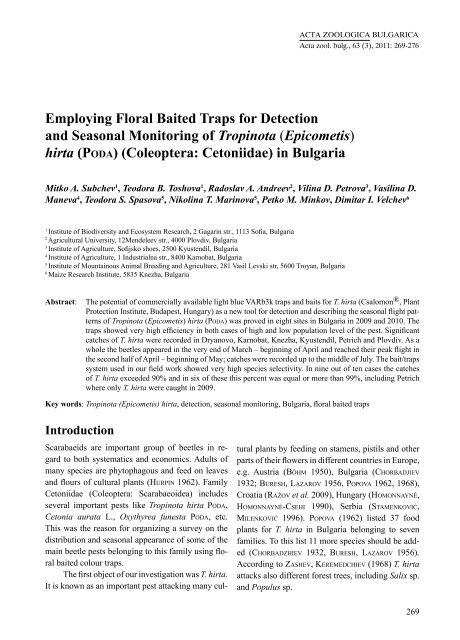
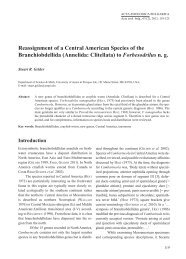
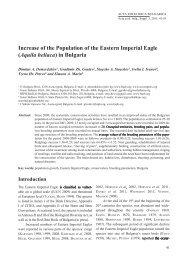
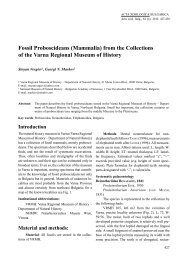
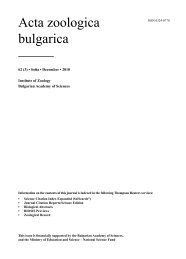
![table of contents [PDF] - Acta zoologica bulgarica](https://img.yumpu.com/52655255/1/186x260/table-of-contents-pdf-acta-zoologica-bulgarica.jpg?quality=85)
![table of contents [PDF] - Acta zoologica bulgarica](https://img.yumpu.com/52655254/1/186x260/table-of-contents-pdf-acta-zoologica-bulgarica.jpg?quality=85)
